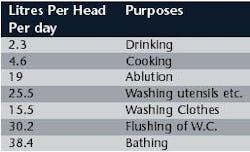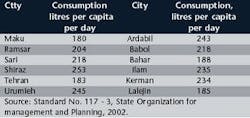Urban growth increasing water consumption in Iran
By Dr. Mohammad Taghi Sheykhi
Rapid urbanisation in Iran has created serious pollution and shortages of water supply resources within the past 20 years, a period in which urban populations increased on average one percent each year. Under such changing conditions, the country needs greater ability to manage cities, preserve water resources, and to provide adequate quality of life to urban residents.
In Iran, the rural to urban migration accounts for more than half of urban growth. Indeed, the urban populations of the country tend to be heavily concentrated in the younger ages, and particularly in the main reproductive ages— all needing larger quantities of water for different purposes.
Tehran, the capital city, faces many challenges due to its high population growth despite its image as a prosperous city. Many people live in slums and they need to be provided with basic services and infrastructure, such as water and sanitation. Urban sanitation services increased during the 1990s, while water supply services declined slightly due to rapid urbanisation.
The lifestyle of residents in urban agglomerations and their economic conditions affect water use in different parts of the country. In Iran, the total consumption of water per head per day varies widely, i.e. from 70 to 900 litres or more. Total consumption depends upon climatic conditions, cost of water supply, customs and habits of inhabitants, pressure in pipelines, population, amount of water available from the private sources, size of gardens and lawns, and the status or financial position of people. Besides these, sewerage systems increase consumption, while metering reduces consumption. In addition, the efficiency of management systems, type of industrial activity, and the quality of water supplied affect consumption.
The probable demand of water by the urban community is important since it fixes the size and capacity of water supply units. The total quantity of water can be estimated by ascertaining different purposes for which the supply is necessary, and the quantity likely to be used under each item of supply.
According to Iranian standards, the minimum domestic requirements of water is 135 litres; however many households use much more than the recommended and advisable quantity. Less water per head per day is consumed in traditional building / households than by those living in modern apartments.
Urban water consumption varies throughout the year in Iran; hence adequate education must be delivered to urban residents through the mass media to consume water more wisely.
So far as the population is concerned, the rate of consumption per capita is greater in large towns than in small towns. Per capita consumption also increases with the growth of a community due to greater industrial demands, increased use for municipal purposes, and other factors. Consump-tion continues to increase by 10% to 15% independent of any increase in population due to improved housing, rising standards of living and public health. All these factors should be carefully considered for designing any scheme.
The average daily consumption varies very widely in different cities in Iran from 135 to more than 300 litres, as it also varies from 135 to 225 litres in different cities in England, from 300 to 400 litres in the USA, and up to 1,000 litres in Rome, Italy.
Generally speaking, inadequate water supply and sanitation services can lead to social and economic poverty of people. Financial assistance must be made available to improve these services within the growing urban centres of Iran and to fund the urgent measures necessary to control environmental and water pollution. Water supply and sanitation services must be considered essential requisites of the community life of every civilised society.
Author's NoteDr. Mohammad Taghi Sheykhi is an associate professor of sociology at the Al-Zahra University in Tehran, Iran. For more information, contact the author at Email: [email protected].


